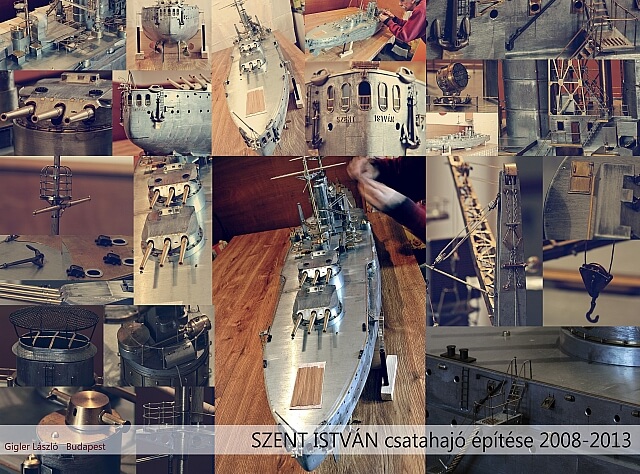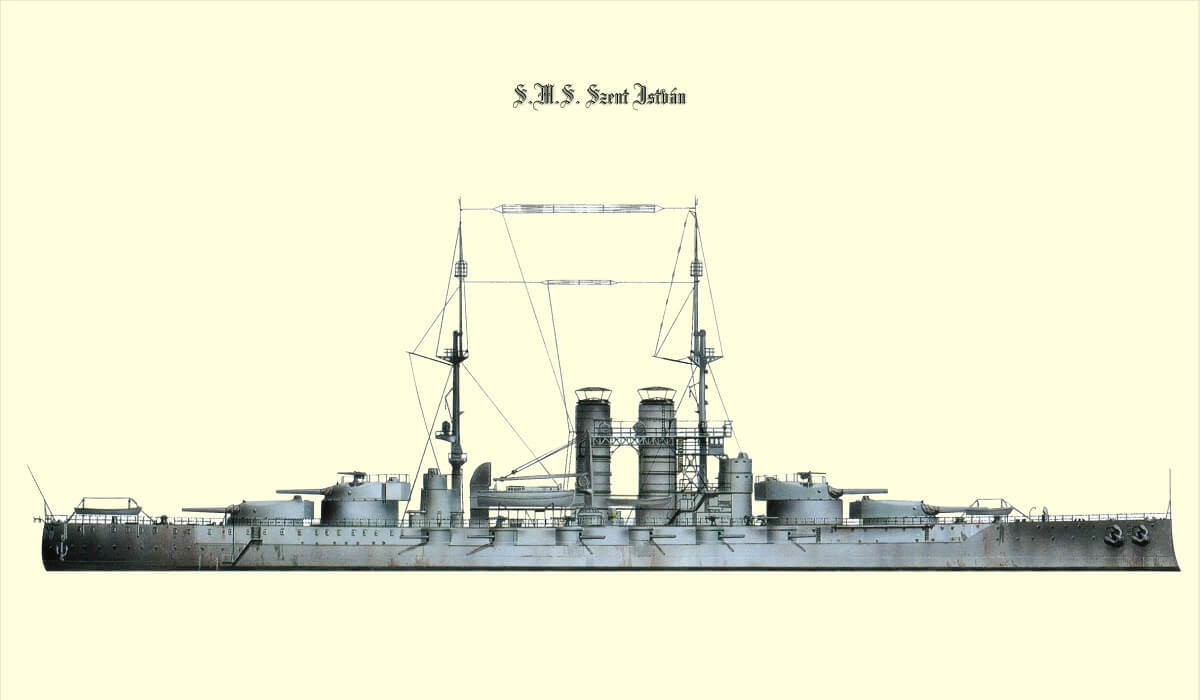⚓ SMS SZENT ISTVÁN ⚓
 dreadnought battleship (1914-1918)
dreadnought battleship (1914-1918)




 A hajó története
A hajó története
(Vikipedia)
Az SMS Szent István az Osztrák-Magyar Monarchia haditengerészetének Tegetthoff-osztályú csatahajója volt, amelyet Szent Istvánról, az első magyar királyról neveztek el.

A magyar országgyűlés megajánlotta a csatahajók megépítéséhez szükséges pénzt, azzal a feltétellel, ha az egyiket a magyar Ganz-Danubius építheti meg. Montecuccoli admirális állapodott meg a magyar királyi kereskedelmi miniszterrel a magyar részvétel arányában.
A Szent Istvánt a Ganz-Danubius Fiumében lévő hajógyárában építették. Az építés megkezdése előtt új sólyateret kellett építeni, mert a korábbi nem volt alkalmas ilyen méretű hajó építésére.
A Szent István annyiban tért el testvérhajóitól, hogy ezen a hajón az első kémény köré egy platformot építettek, ami a parancsnoki hídtól egész a hátsó kéményig tartott, és számos fényszórót helyeztek rá. További különbség volt még, hogy ez a hajó nem volt torpedóhálóval ellátva, valamint a főárboc előtt is a többi hajón lévőtől eltérő ventilátor helyezkedett el. Míg a testvérhajói négy, addig a Szent István kettő hajócsavarral rendelkezett.
A Szent Istvánt 1915-ben állították hadrendbe.
A világháborúban hadrendbe állítása után a Szent István főként a pólai kikötőben tartózkodott, melyet csak lőgyakorlatok idejére hagyott el. Részt vett Póla légvédelmében.
Első és egyben utolsó harci bevetésére 1918. június 9-én éjjel futott ki egy kötelék tagjaként azzal a céllal, hogy feltörjék az Otrantói-szorosban lévő tengerzárat. Ugyanekkor Anconából két olasz torpedónaszád két MAS motorcsónakot (MAS-15 és MAS-21 jelzésűek) vontatott ki. Az volt a feladatuk, hogy kifürkésszék a Gruzia- és Selve-sziget közötti forgalmat és mérjék föl az aknazárakat.
Június 10-én hajnalban Luigi Rizzo korvettkapitány, a MAS-15-ös parancsnoka észrevette a Szent Istvánt és a Tegetthoff nevű testvérhajóját a Premuda-szigettől délkeletre. Rizzo úgy döntött, hogy megtámadja a csatahajókat. 500 méterről kilőtte a Szent Istvánra mindkét torpedóját. Néhány másodperc múlva - fél négykor - két robbanás hallatszott. A 76T jelű torpedónaszád csak ekkor vette észre a MAS-15-öst. Utánaeredt, de a motorcsónaknak sikerült leráznia a naszádot.
A torpedók a jobb oldali első és második kazánházat találták el, valamint átszakították a válaszfalat is. A lék a vízvonal alatt 5 méterrel volt, így a hajó azonnal 10 fokban megdőlt. A dőlés mértékét sikerült 7 fokra csökkenteni. A hajó sebessége csökkent és a part felé vette az irányt. A Tegetthoff megpróbálta elvontatni, de a vonatókötél elszakadt. Egyre több víz került be a hajótestbe. A hajó 6 óra 5 perckor felborult, majd 7 perc múlva elsüllyedt.
A Tegetthoff-osztály tervezési hibái (alacsony vízkiszorítás, magasan lévő súlypont és a 12 darab 305 mm-es löveg óriási súlya) miatt a hajó gyorsan elsüllyedt. Köszönhetően a gyorsan érkező segítségnek és annak, hogy az Császári és Királyi Haditengerészetnél követelmény volt, hogy a tengerészek tudjanak úszni, a hajó 1087 főnyi legénységéből sokan megmenekültek - 85 matróz és 4 tiszt vesztette életét.
A Szent István egyike annak a kevés hajónak, melyeknek elsüllyesztését filmre vették. A másik kettő az angol HMS Barham és az amerikai USS Arizona. A filmből befolyó pénzt a Vöröskeresztnek ajánlották fel.
 The story
The story

(Vikipedia)
Construction
Szent István was laid down on 29 January 1912 at Ganz & Company's Danubius yard at Fiume (Rijeka), the only large Hungarian shipyard in Croatia as Hungarian: János Hunyadi, commemorating the Hungarian national hero.
Ganz & Company was awarded the contract to build the battleship in return for the Hungarian government agreeing to the 1910 and 1911 naval budgets. This involved great expense by the Hungarian government, as the yard had hitherto only built smaller merchant ships for, amongst others, Österreichischer Lloyd, and therefore had to be itself refitted for the building of larger vessels.
However she was renamed Szent István by order of the Emperor Franz Joseph before she was launched on 17 January 1914. It was customary for either the Emperor or his heir to be present at the launching of a major warship, but Franz Joseph was too feeble and his heir, Archduke Franz Ferdinand, refused to be there as a consequence of his anti-Hungarian attitudes. Franz Joseph sent a telegram of congratulations that negated the snub offered by his heir.
During the launching itself there was an accident when the starboard anchor had to be dropped to prevent the ship from hitting a ship carrying spectators, but the anchor chain had not been shackled to the ship and it struck two dockworkers, killing one and crushing the arm of the other.
Her fitting out was delayed by the start of the war, but she was finally commissioned on 13 December 1915.
Service
Szent István was based at Pola (Pula) for the duration of her career. In fact she rarely left port except for gunnery practice in the nearby Fažana Strait.
She only spent 54 days at sea during her 937 days in service and made only a single, two-day, trip to Pag Island. Only 5.7% of her life was spent at sea; for the rest of the time she swung at anchor in Pola Harbour. She was never even drydocked to get her bottom cleaned.
Her tenure in Pola was livened up by a visit from the new Emperor Karl I on 15 December 1916 and another by Kaiser Wilhelm on 12 December 1917 during his inspection of the German submarine base there. The Italians conducted no less than eighty air raids on Pola between 1915 and 1917 which undoubtedly kept the crews of her anti-aircraft gun busy.
Sinking
By 1918, the Allies had strengthened their blockade on the Strait of Otranto. As a result, it was becoming more difficult for German and Austro-Hungarian U-boats to get through the strait and into the Mediterranean. In response to these new measures at blockading the straits, the new commander of the Austro-Hungarian Navy, Konteradmiral Miklós Horthy decided to launch an attack on the Allied defenders with battleships, scout cruisers, and destroyers.
During the night of 8 June, Horthy left the naval base of Pola with Viribus Unitis and Prinz Eugen.
At about 11:00 pm on 9 June 1918 Szent István and Tegetthoff, escorted by one destroyer and six torpedo boats, departed Pola, after some troubles getting the harbour defense barrage opened. They were en route to the harbour at Slano, north of Dubrovnik (Ragusa) to rendezvous with Viribus Unitis and Prinz Eugen, for a coordinated attack on the Otranto Barrage.
At about 3:15 am on 10 June, two Italian MAS boats, MAS 15 and MAS 21, spotted the smoke from the Austrian ships while returning from an uneventful patrol off the Dalmatian coast. The MAS platoon was commanded by Capitano di corvetta Luigi Rizzo, who had sunk the Austro-Hungarian coastal defense ship SMS Wien in Trieste six months before.[15] The individual boats were commanded by Capo timoniere Armando Gori and Guardiamarina di complemento Giuseppe Aonzo respectively.
Both boats successfully penetrated the escort screen and split to engage each of the dreadnoughts.
MAS 21 attacked Tegetthoff, but her torpedoes failed to hit the ship.
MAS 15 fired her two torpedoes successfully at 3:25 am at Szent István.
Both boats evaded any pursuit although MAS 15 had to discourage the torpedo boat Tb 76 by dropping depth charges in her wake. Tegetthoff thought that the torpedoes were fired by submarines and pulled out of the formation and started to zigzag to throw off any further attacks. She repeatedly fired on suspected submarine periscopes until she rejoined her half-sister at 4:45.
Szent István was hit by two 45-centimetre (18 in) torpedoes abreast her boiler rooms. The aft boiler room quickly flooded and gave the ship a 10° list to starboard. Counterflooding of the portside trim cells and magazines reduced the list to 7°, but efforts to use collision mats to plug the holes failed. While this was going on the dreadnought steered for the nearby Bay of Brgulje at low speed. However, water continued to leak into the forward boiler room and eventually doused all but the two boilers on the port side. This killed the power for the pumps and only left enough electricity to run the lights. The turrets were trained to port in a pointless effort to counter the list and their ready ammunition was thrown overboard.
An attempt by Tegetthoff to take the crippled battleship into tow was also abandoned after it became clear that Szent István was doomed. Flooding continued, and Szent István capsized at 6:05 am off Premuda Island.
Only 89 sailors died-41 from Hungary-the low death toll partly attributed to the fact that all sailors with the KuK Navy had to learn to swim before entering active service.
Film footage exists of Szent István's last half-hour, taken by Linienschiffsleutnant Meusburger of the Tegetthoff with his own camera as well as by an official film crew. The two films were later spliced together and exhibited in the United States during the Great Depression.

SMS SZENT ISTVÁN dreadnought side view